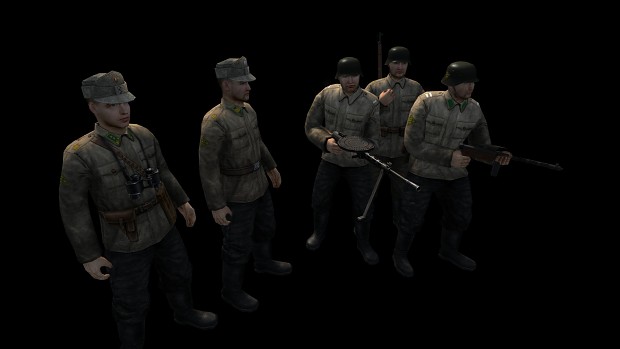This modification will add Finnish faction to Men of War Assault Squad 1 & 2 along with multiple campaigns for the Finnish side. The campaigns will be based on Winter war's last battles, Continuation war's "attack phase", advance along Kirov-railway in 1941 and 1942, defensive battles of 1944 and Lapland war. Each faction will be unique and player has to adapt his play-style to use advantages and disadvantages to defeat their enemies. German faction has most elite infantry formations, but they lack heavier tanks and heavy artillery. Russians are well armed, have heavy-armor support, have more infantry, but their infantry aren't as well trained and experienced as Finnish and German counterparts. Finnish faction will be "in-between" the Germans and USSR, having enough equipment for attacks & defending areas. Shortcomings of the Finnish faction is lack of mobility and the tank costs.
Jaegers from the Jaeger Brigade of the Armored Division, June 1944. The soldiers in the picture have M/36 summer tunic. The lieutenant and the staff sergeant on the left have M/36 field caps. Rest have German helmets. The corporal on the far right has divisional insignia painted on his helmet. Jaegers also have their divisional sleeve insignia which was the only sleeve insignia to be approved by the Headquarters during the war.
During World War II, there was an distinction between normal infantry and Jaeger formations. Infantry formations were more static and they normally operated in regiment size, excluding special organizations like separate battalions and brigades. Independent Jaeger units were usually battalion sized and they were largely mobilized: infantry moving mainly with bicycles and logistics moving by trucks opposed to horses many units had to resort into.
In 1941 there were two Jaeger Brigades formed from battalion sized Jaeger units. Armored Battalion was attached to the 1st Jaeger Brigade which was known as "Osasto Lagus" after its commander. When the advance stopped on Eastern Karelia the 2nd Jaeger brigade was disbanded and the Armoured Division was formed from the 1st Jaeger Brigade, remaining elements of the 2nd and the Armored Battalion. The Finnish Army had captured enough equipment to increase the size of the battalion into brigade, thus the division was organized into two brigades and its support formations.
The division was known for its good morale and they trained extensively from 1942 to 1944 when there were not many notable engagements against Finland. Training proved useful in 1944 when the division took part in numerous engagements in the Karelian isthmus: Most notably the battles of Kuuterselkä, Tali and Vuosalmi. Due the nature of the formation, it suffered many casualties; however the division played an important role on stalling the Soviet offensive.
After the war the division was downscaled into a brigade which still exists.






